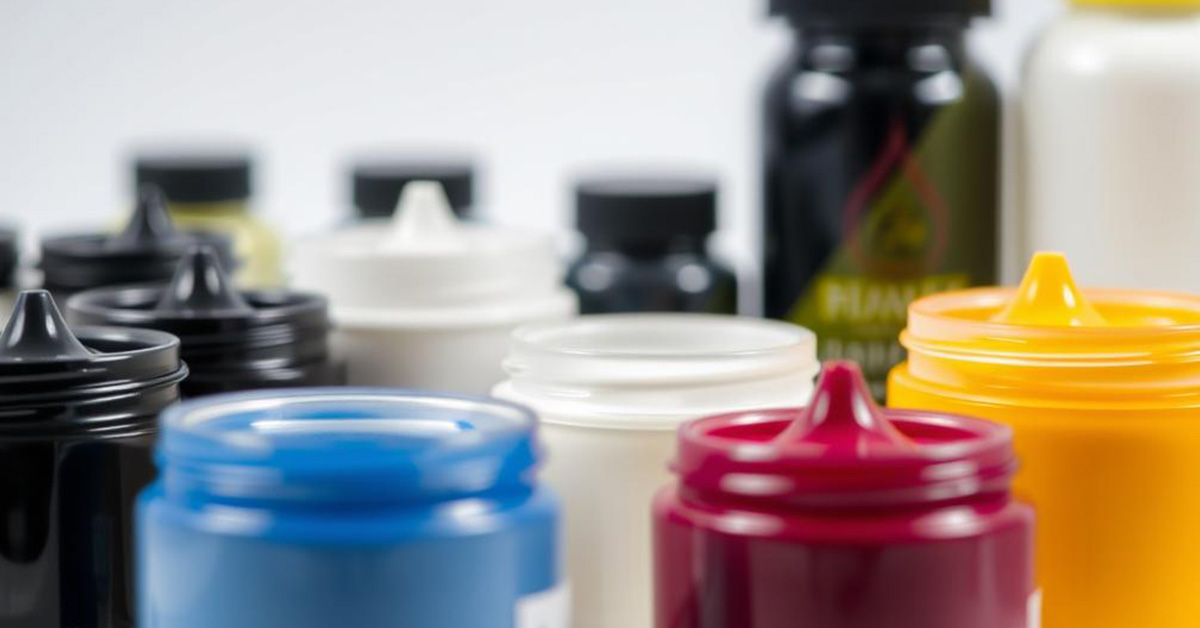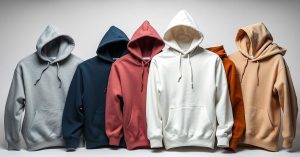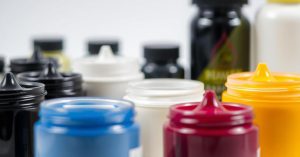Screen printing inks are the backbone of most printed apparel because they deliver vibrant colors that survive dozens of washes without fading. When businesses invest in custom t shirt printing, one of the first questions they ask is what ink will hold up best for their specific needs, and that decision often determines the success of the entire production run.
This guide breaks down seven common inks used in the industry: plastisol, water-based, discharge, metallic, foil transfers, glow-in-the-dark, and specialty inks like puff and glitter. Each option brings its own set of strengths when it comes to color saturation, hand feel, durability, and cost, so understanding these differences helps you pick the right match for your project.
The ink you choose depends heavily on the t shirt printing type you use and your fabric. Screen printing typically relies on thick plastisol inks for bold, opaque designs on dark cotton garments, while digital methods like DTG use water-based formulas that soak into the fibers for a softer, more breathable finish. No single ink works perfectly for every scenario, and the best choice comes down to fabric composition, design complexity, production volume, and the look you’re trying to achieve.
Key Takeaways
- Ink type directly affects appearance, texture, breathability, and how well designs hold up through repeated washing.
- Plastisol remains the most commonly used ink in the industry because it delivers opaque, durable prints at scale.
- Water-based and DTG-compatible inks produce a soft hand feel and photorealistic color reproduction on natural fabrics like cotton.
- Special-effect inks such as metallic, puff, and foil add visual impact but require adjusted curing protocols and come at a higher price point.
- Matching ink choice to fabric type, print method, and production goals ensures the best results for both quality and cost efficiency.
Table of Contents
What Ink Is Used for T-Shirt Printing
Choosing the right ink is one of the most important decisions in t-shirt production because the ink chemistry determines whether your design sits on top of the fabric or blends into it. This choice affects not only the visual appearance but also the texture, breathability, and overall comfort of the finished garment.
Opacity and color saturation play a major role in how your design translates from screen to shirt. Plastisol ink delivers bright, vibrant colors even on dark garments because it sits on the surface with high coverage, while water-based and discharge inks offer a more muted, vintage aesthetic but may require an underbase layer when printing on black or navy fabric.
Cure temperature and durability determine how long your prints will last. Some inks need to be heat-cured at precise temperatures to properly bond with the fabric, and if the curing process is rushed or inconsistent, you’ll end up with prints that crack, fade, or feel uncomfortably stiff after just a few washes. Learning how to keep print on shirts from cracking starts with selecting the right ink and curing it correctly.
Special effects and resolution matter when fine details are involved. Heavy-bodied inks like metallics, foil, and thick plastisol layers can limit your ability to reproduce intricate linework, while thinner water-based inks used in DTG and DTF printing allow for photo-realism and smooth color gradients that rival traditional photography.
Production realities also come into play. Screen printing remains the most cost-effective option for large runs because setup costs drop significantly as order quantity increases, but for smaller batches or highly detailed multi-color designs, DTG or transfer methods offer faster turnaround and greater color flexibility without expensive screen creation.
Why Ink Selection Affects Final Results
Fabric chemistry and ink type work together to determine the final outcome. Cotton absorbs discharge and DTG inks beautifully for a soft, breathable finish, while polyester requires dye sublimation to bond the dye molecules directly into the synthetic fibers for permanent, vibrant results.
Design goals guide your ink decision. If you’re aiming for a vintage, lived-in look, water-based or discharge inks deliver that soft, faded aesthetic right out of the gate, but if you need bold, punchy colors on dark shirts with exact Pantone matching, plastisol is often the go-to choice for its superior opacity and color consistency.
Environmental and workflow concerns also factor in. Water-based inks are more eco-friendly and easier to clean up than oil-based plastisol, but they dry faster in the screens and require careful humidity control to prevent clogging, so many shops choose inks that align with their equipment capabilities and waste management practices.
How Printers Decide Which Ink to Use
Screen printers evaluate fabric content, artwork complexity, order size, and desired finish before committing to an ink. For 100% cotton tees with simple spot-color designs and a run of 500 shirts, traditional screen printing with plastisol offers the best combination of affordability and color matching.
For high-color jobs, photographic images, or one-off orders, DTG or DTF becomes the preferred choice because it maintains sharp detail without the need for expensive screen setups. When working with blended fabrics, printers often lean toward DTF or plastisol because these inks handle the different fiber types without bonding issues.
Desired effects also influence the decision. If a client wants metallic accents that catch the light, metallic plastisol or foil transfers become necessary, whereas soft, vintage prints call for water-based or discharge inks that deliver the right hand feel and visual tone.
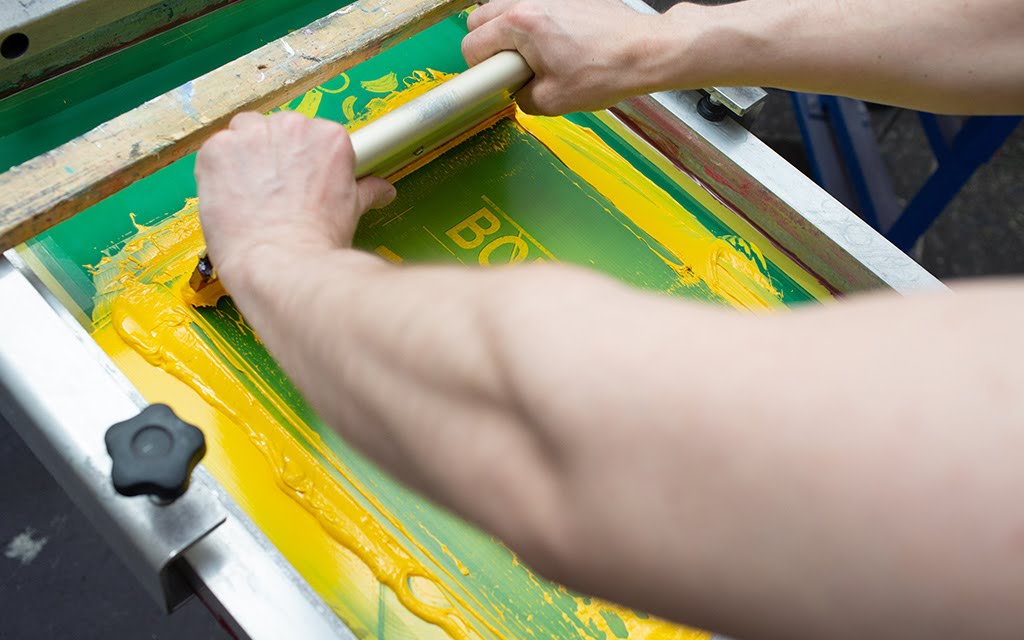
Plastisol Ink for Screen Printing: The Industry Standard
Plastisol ink is the workhorse of commercial screen printing because it’s thick, oil-based, and delivers exceptional opacity that makes colors pop even on dark garments. This ink has dominated the industry for decades thanks to its reliability, color consistency, and ability to hold up through hundreds of wash cycles.
Plastisol inks require heat to cure, typically around 320°F (160°C), which causes the PVC particles within the ink to fuse together and bond to the fabric surface. This curing process is what gives plastisol its legendary durability, keeping designs sharp and colors vibrant even after repeated washing and wear.
Key Characteristics of Plastisol Ink
Plastisol ink sits on top of the fabric fibers rather than soaking in, which creates a slightly raised texture and a subtle sheen that many customers associate with professional screen printing. It’s extremely opaque, meaning even light-colored designs on black shirts retain their brightness without requiring multiple passes, and it mixes easily for precise spot-color matching that brands depend on for consistent logo reproduction.
Pros and Cons
Advantages | Disadvantages |
Extremely durable through 50+ washes | Heavier hand feel compared to water-based options |
Excellent opacity on dark garments | Can scorch or deform heat-sensitive fabrics if cured incorrectly |
Long shelf life, doesn’t dry in screens | Thicker texture may feel less breathable |
Cost-effective for bulk orders | Prints over seams or pockets may appear uneven |
Mixes easily for exact Pantone matching | Less eco-friendly than water-based alternatives |
Plastisol inks for screen printing are incredibly durable, making them ideal for designs that need to survive frequent laundering without losing color intensity. They hold fine details well and remain cost-effective when producing large runs, which is why they’re the go-to choice for promotional apparel and team uniforms.
But plastisol does have drawbacks. The cured ink creates a heavier, less breathable layer on the fabric, and if your curing temperature is too high or applied too long, the ink can scorch or the fabric itself can deform. Prints that cross over seams, pockets, or uneven surfaces may not adhere evenly, and the overall hand feel will always be thicker than what you’d get with water-based alternatives.
Use Cases and Production Notes
Plastisol inks work best for sportswear, promotional merchandise, and any high-volume order where durability and color vibrancy are priorities. When printing on dark garments, an underbase layer of white plastisol is almost always printed first to ensure that the top colors maintain their brightness and don’t get muted by the fabric underneath.
For special effects, plastisol serves as the base for metallics, puff additives, and transfer applications. To get the best results, you’ll need to match your mesh count to your ink viscosity, control your curing time and temperature precisely, and always test on fabric swatches from the actual production batch to avoid surprises.
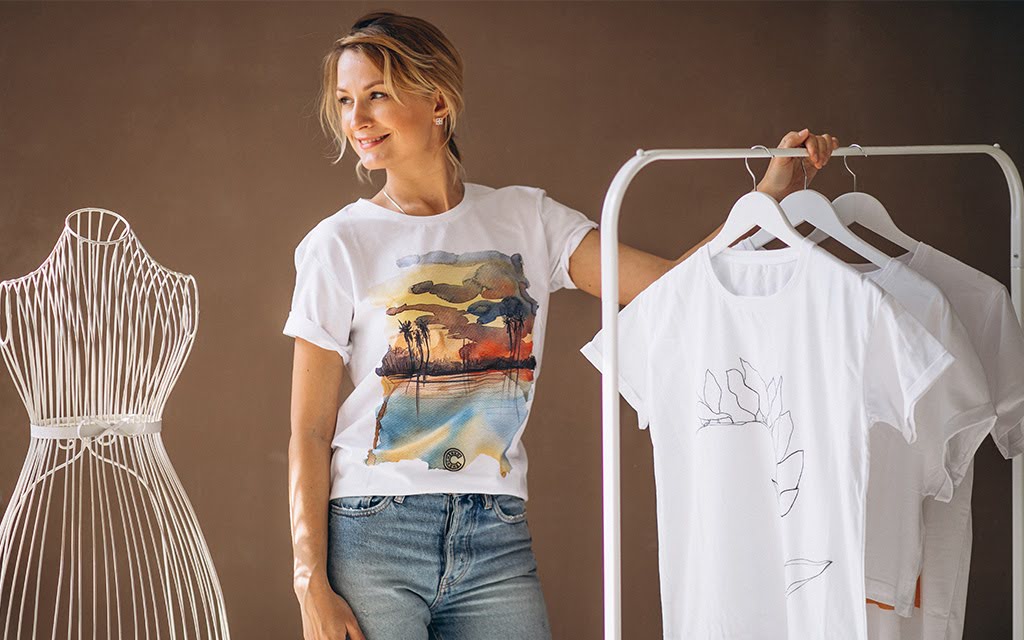
Water-Based Inks and Soft-Hand Printing
Water based inks have become the preferred choice for boutique print shops and eco-friendly brands because they create prints that feel like part of the fabric rather than sitting on top of it. This produces a soft, breathable finish that’s particularly appealing for premium lifestyle apparel and everyday casual wear.
Characteristics of Water Based Ink
Water based inks combine water, pigments, and binders without relying on solvents or oils, which allows the ink to penetrate the fabric fibers and become part of the textile itself. The result is a finish that feels soft and breathable, almost like a well-worn vintage tee straight off the rack.
These inks dry faster than plastisol, so print shops need to manage ambient humidity carefully and use retarders or other additives to keep the screens from clogging mid-run. On dark garments, achieving bright colors can be challenging without additional underbase layers or specialized techniques.
Advantages and Limitations
The biggest advantage of water-based inks is comfort. Prints feel light and breathable instead of sitting on the fabric like a heavy plastisol layer, which makes them perfect for lightweight summer tees and high-end fashion pieces. Cleanup is easier because you’re washing out water-based ink instead of using harsh chemicals, making the entire printing process more eco-friendly.
But there are trade-offs. Water-based inks dry quickly in the screens, which means more frequent cleaning and maintenance during long production runs. Achieving bright whites or vivid colors on black shirts requires extra steps like discharge printing or multiple passes, and color matching can be trickier for printers who are used to the predictability of plastisol formulations.
Best Fabrics and Techniques
Natural fibers like 100% cotton work best with water-based inks because the fibers absorb the ink and allow it to bond deeply, creating that signature soft hand feel. For darker fabrics, printers use discharge techniques or specialized water-based formulas that maintain brightness while preserving the soft, breathable texture.
To get clean results, you’ll need to use the appropriate mesh counts, flash cure between color layers to prevent bleeding, and add retarders to slow down the drying process in the screens. Some printers even combine water-based and plastisol inks in the same design to get the benefits of both.
Water-based inks are perfect for lifestyle brands, limited-edition releases, and any product where the customer values comfort and sustainability as much as visual impact. Understanding t shirt printing methods pros and cons helps you decide when water-based makes sense for your project.
Discharge Ink for Vintage Looks and Softness
Discharge printing offers a unique approach to achieving soft, worn-in aesthetics while maintaining breathability and comfort. It’s the secret weapon for printers who want to create that perfect vintage look on dark garments without sacrificing hand feel.
How Discharge Works and Fabric Compatibility
Discharge ink uses a water-based solution mixed with an activator that removes the dye from the fabric, then replaces it with pigment or leaves a bleached, tone-on-tone effect. This process works best on 100% cotton garments that have been dyed with reactive dyes, which is why testing is so important.
Discharge inks don’t work well on synthetic fibers and can produce unpredictable results on cotton-poly blends. Always test a sample from the same dye lot before committing to a full production run because different fabric batches can react differently even from the same manufacturer.
Visual and Tactile Results
Discharge creates incredibly soft, muted tones that are perfect for retro-inspired designs and vintage aesthetics. It produces a tone-on-tone or subtly faded look on dark shirts that’s hard to replicate with other methods, though achieving bright, crisp whites can be challenging depending on the fabric’s dye chemistry.
The hand feel is what sets discharge apart. Prints feel like they’re part of the fabric because the ink replaces the dye rather than sitting on top, making it ideal for premium tees where comfort is a selling point. Brands like Bella+Canvas and American Apparel have built reputations around this ultra-soft printing technique.
Pros, Cons and Production Tips
Advantages | Disadvantages |
Extremely soft, breathable prints | Only works on 100% cotton (limited fabric options) |
Perfect for vintage, retro aesthetics | Color brightness can be unpredictable |
No raised texture, feels like fabric | Requires precise mixing and curing protocols |
Works well over seams and pockets | Dye chemistry varies between fabric batches |
Premium look and feel | Higher skill level needed for consistent results |
Discharge is perfect for high-end casual wear and any project where softness and breathability are priorities. It handles seams and pockets better than raised plastisol prints because there’s no thick ink layer to crack or peel.
But it comes with limitations. You’re restricted to 100% cotton garments, and the fabric’s dye chemistry plays a huge role in how the colors turn out. You’ll need to follow exact curing profiles, mix the activator carefully, and test on garments from the same dye lot to avoid surprises during production.
For best results, test samples from the actual production batch, adjust cure temperature and dwell time as needed, and use discharge with added pigments when you need more precise color control. Avoid using discharge on heat-sensitive fabrics and always keep approval swatches for client sign-off.
Metallics, Foil, Glow, and Other Special-Effect Inks
Special-effect inks add visual drama and tactile interest that standard inks simply can’t match. Designers turn to metallic ink, glitter, puff, high-density, and reflective ink when they want their designs to stand out under lights, create texture, or deliver a premium luxury feel.
Metallic Plastisol Inks
Metallic ink printing combines metallic flakes with a plastisol base to create a shimmering, eye-catching finish that reflects light beautifully. These inks are thicker than standard plastisol, so printers use lower mesh counts to allow proper ink deposit and achieve that true metallic effect.
The thickness of metallic inks can limit fine detail reproduction, and mixing multiple metallic colors can dilute the shine, making precise color matching difficult. Use metallic inks for logos, accent elements, and premium apparel where a bright, reflective finish is the priority.
Foil Transfers and Adhesive Prints
Foil transfers aren’t technically ink but rather a multi-step process where a clear adhesive plastisol or specialized adhesive ink is printed first, then a foil sheet is heat-pressed onto the tacky surface. This creates a high-shine, luxurious finish that works particularly well for small design elements and accent details.
Foil transfers don’t allow for traditional color mixing, and large coverage areas may crack or peel if the application process isn’t carefully controlled. They require precise temperature and pressure settings during the heat-press stage, and customers need clear care instructions to keep the finish intact through washing.
Glow-in-the-Dark and Specialty Pigment Inks
Glow-in-the-dark inks use phosphorescent pigments suspended in a transparent plastisol base, typically with a faint greenish tint in daylight. These inks need a light-colored underbase to glow effectively because they store ambient light and emit it slowly in darkness, making them perfect for novelty items, safety apparel, and children’s clothing.
Specialty pigment inks offer effects beyond glow, including thermochromic (color-changing) and photochromic options, though each comes with specific handling requirements and limited color matching capabilities. When properly cured, stored away from extreme heat, and formulated to meet safety standards, these inks are safe for all apparel including children’s garments.
Puff, High-Density, Glitter and Other Effects
Puff inks expand when heated to create raised, three-dimensional textures that add tactile interest. High-density inks build sculpted thickness for bold, dimensional designs, while glitter inks embed reflective particles that catch light and create sparkle.
Printers must carefully select mesh counts, adjust squeegee pressure, and control flash curing and final cure temperatures to achieve the desired effect with each specialty ink type. These finishes create strong visual and tactile appeal, which is why brands use them for standout details and premium product lines.
Special Effect | Best Use | Main Drawback |
Metallic | Logos, accents, premium apparel | Limits fine detail, thicker hand feel |
Foil Transfer | Small accents, luxury finish | Can crack if applied incorrectly |
Glow-in-the-Dark | Novelty items, safety gear | Needs light-colored base, faint tint in daylight |
Puff | Dimensional text, bold graphics | Brittle in large areas, altered texture |
Glitter | Fashion accents, eye-catching details | Rough texture, higher cost |
The trade-offs include higher material costs, altered hand feel, and more detailed care requirements during laundering. Large-area coverage with textured or foil finishes can become brittle over time, so it’s best to limit these effects to accent areas when longevity matters most.
Production requires experienced screen printers who can control squeegee pressure, manage flash curing between layers, and dial in final cure temperatures precisely. Providing proper laundry care guidance helps customers preserve metallic, foil, glow, and other specialty finishes for the longest possible lifespan.
Ink Choice vs. Printing Method: DTG, DTF, Sublimation, Vinyl and Transfers
Choosing the right ink goes hand-in-hand with your printing method because different techniques require specific ink formulations to work properly. Direct-to-garment (DTG) uses water-based pigment inks that produce photo-realistic prints on cotton, making it ideal for complex, multi-color designs and print-on-demand operations where you’re producing one shirt at a time.
DTG requires proper pre-treatment and precise curing to ensure durability and maintain that soft hand feel. Direct-to-film (DTF) prints water-based inks onto a PET film carrier, then heat-presses the design onto almost any fabric type, making it versatile for both light and dark garments while delivering vivid colors, though the hand feel is less natural than DTG.
Dye sublimation bonds dye molecules directly to polyester fibers through heat and pressure, creating breathable, long-lasting prints that won’t crack or peel. It’s perfect for athletic wear and all-over prints, but it only works on synthetic fabrics like polyester, which limits your garment options.
Heat transfer vinyl (HTV) creates a raised, highly durable finish that’s ideal for lettering, numbers, and bold graphics. Plastisol transfer printing offers screen-print quality with specialty finishes and more flexibility for small runs, while transfer papers and print-cut methods work well for complex color jobs or one-off orders, though they may produce a glossier or more plastic-like feel.
Practical guidance comes down to matching fabric to method: cotton works best with DTG and plastisol, polyester requires dye sublimation, and blends often perform best with DTF. Always test on actual garments from the same dye lot, follow proper cure and pre-treatment protocols, and when you need special effects, bulk pricing, or tight color control, consult a local print shop that understands the nuances of each method.
Picking the right ink and printing method determines whether your finished apparel meets expectations for look, feel, durability, and budget. Comparing t shirt print vs embroidery or researching what type of t shirt printing lasts the longest helps you make informed decisions that balance quality with cost efficiency.

